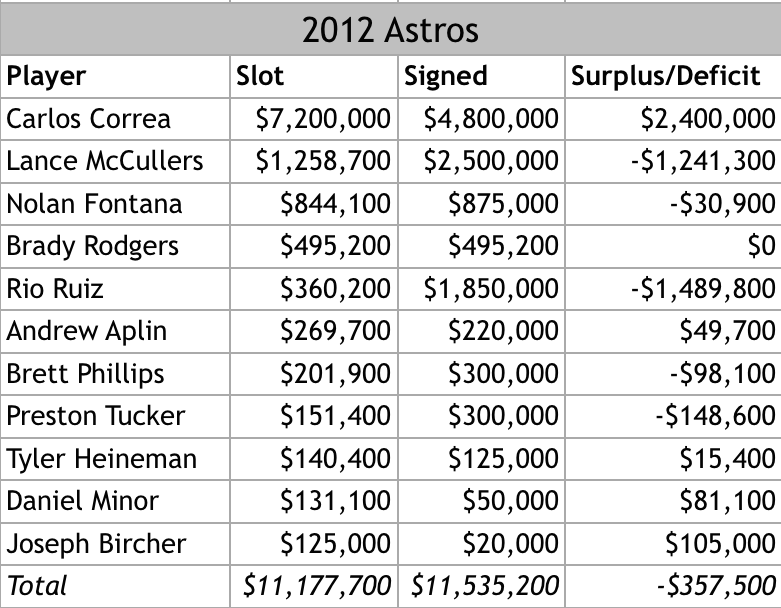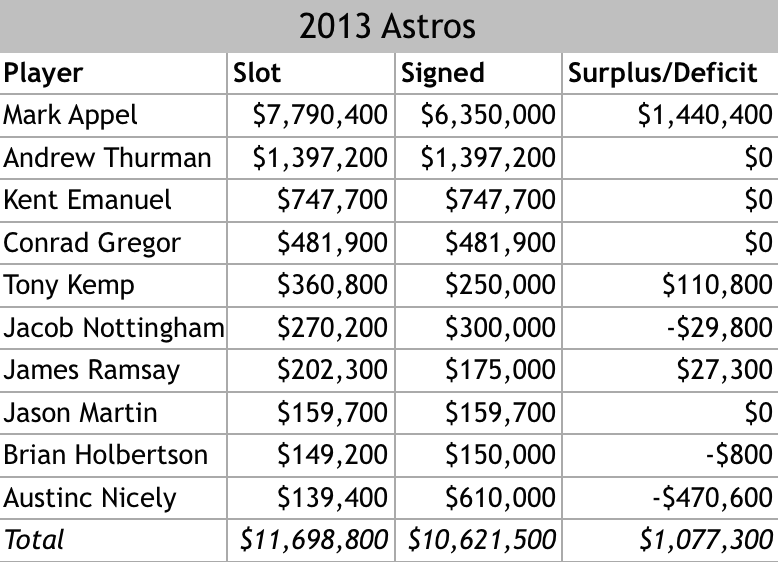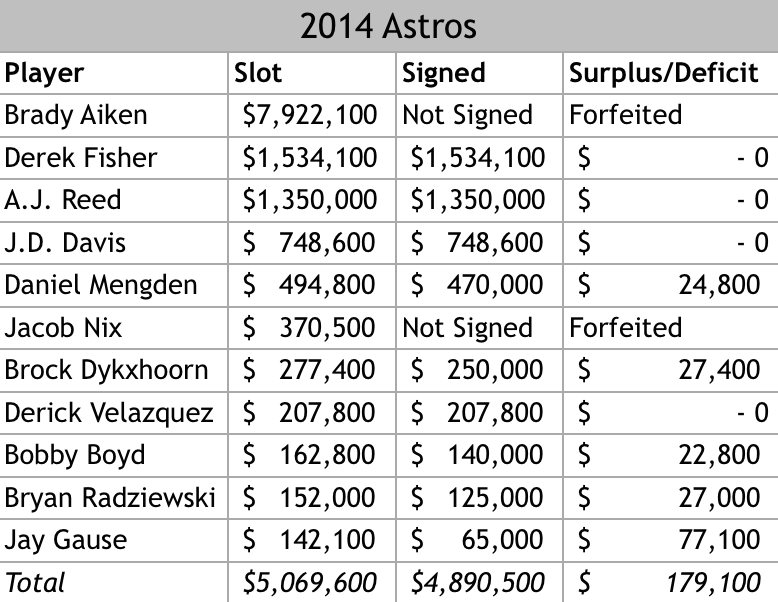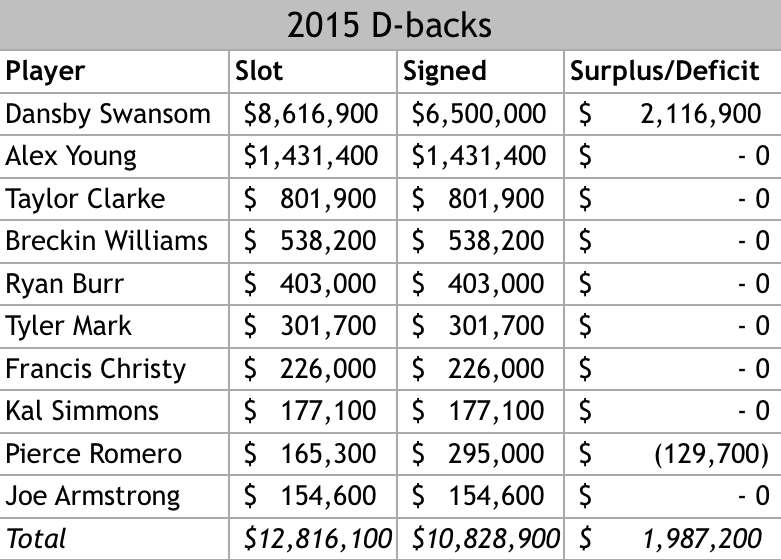D-backs’ 2015 Draft: Not Altogether a Success
Through two rounds, no one could really complain with what the Diamondbacks did in the 2015 first-year player draft. Getting Dansby Swanson was a win as it provides the organization with a player who fits the timeline and is tremendously talented. Selecting Alex Young was another savvy move as he was in-demand and looks like a safe bet to make it to the majors as a staring pitcher. Both players fit right into the front half of the Diamondbacks’ Midseason Top 10 Prospect list. From a value standpoint, that’s everything one could hope for.
Yet, the Diamondbacks received some critique for how they handled the draft. Last week, I came across this and it really confirmed something I’d been interested in:
The @Dbacks underspent their @MLBDraft bonus pool by nearly $1.7 mil. Poor use of what should have been a strategic advantage.
— Jim Callis (@jimcallisMLB) July 17, 2015
Callis is well-respected when it comes to the draft, minor league and amateur baseball. His comments speak volumes as he’s not usually known as an alarmist but rather a good indicator of the industry consensus. If he noticed the missed opportunity by the D-backs, surely it was on most everyone’s radar. Yet, it’s hardly been mentioned.
To understand the criticism, you have to understand how the draft works. Since 2012, each pick within the top ten rounds has a value assigned to it by MLB. The sum of those picks represents a particular team’s bonus pool. Teams can sign players with every pick after the 10th round for a $10,000 with no penalty. If they exceed $10,000, every penny over that amount counts against the team’s bonus pool total. Teams can exceed their bonus pools, but there’s an escalating schedule of penalties associated that essentially keep teams from doing this. The few that have gone over have kept it under the 5% overage threshold to avoid losing their first round pick in the next draft.
Of course, that’s just the procedural part. The existing structure tends tor result in two dominant draft strategies, which we explored prior to the draft. These strategies are built around the idea that the draft provides a rare opportunity. It’s one of the few times a team can add talent to its organization. Because it’s heavily regulated, prices are supressed and teams can add this talent at far-below market rates (ex. Touki Toussaint signed for $2.7M after drafted and was dealt for essentially $10M a year later without changing his future valuation significantly. There were also rumblings that other teams would have been willing to pay significantly more than the Braves did…). When the draft rolls around, teams don’t have to deal with the risks associated with the international market or give up talent to get talent as they do in player trades – they get to simply buy players at a steep discount. Sounds pretty good, right?
Truth be told, it’s a hell of a deal, and in this particular draft, the Diamondbacks were in the driver’s seat. They held the first overall choice, then picked first in the following 39 rounds. They didn’t have any competitive balance picks (but they did get one in the 2016 draft the other day) nor did they receive any for losing players who turned down qualifying offers, but they still were in an enviable position. The main reason being that the first slot in the draft, the number one pick that the Diamondbacks held, was valued at $8.6M in 2015, yet no player was expected to sign for more than $6.5M because, as was noted a million times itself, this draft was particularly weak.
The D-backs took Dansby Swanson first and he signed him for the predicted value of $6.5M, over two million dollars less than the number one pick was allowed for. The surplus from this savings could have been used to pay higher-than-slot values to picks in subsequent rounds. The team wouldn’t have just given the money away because they had it, but they could have presumably taken talented players with high bonus demands and actually had a chance to sign them since they had the biggest surplus of any drafting team. This surplus gave them leverage – more leverage than any other team – to acquire top talent because good players are expensive. They’re generally committed to or playing for marquee college teams and will have future options to get to rich through baseball, but for the right price, can be bought. The D-backs had the most money to use for this purpose and a farm system thin on talent, creating a rare alignment of the stars. Yet they failed to capitalize, instead stating that they’d use the savings from the draft purchase free agents.
We’ll leave that last little nugget of information alone for now, but it’s important to put the potential opportunity into perspective. To do so, let’s look at the three previous drafts under the new bonus slot rule structure. Unfortunately, we don’t have a wide variety of teams to study as the Astros held the first pick in the previous three drafts. They did, however, employ a couple of different strategies at the top with mixed results. Let’s first take a look at how these drafts under this structure have gone in the top 10 rounds, since that’s where the money allowed comes from.
In 2012, the first year of the slot system, the Astros spent little on the first pick in Carlos Correa, opting to save money rather than picking the consensus number one talent – Byron Buxton. That obviously worked out well and they used the saving to ink Lance McCullers, Rio Ruiz and Preston Tucker, all sound decisions that are paying dividends. In 2013, they went a different route and played the draft in a pretty straightforward manner, inking Mark Appel, then using the surplus to get a deal done with Tony Kemp, a prospect who’s on the rise. With the remaining cash, they nabbed Austin Nicely away from a commitment to the University of Virginia. In 2014, some unforeseen issues derailed the Astros’ draft. They approached in a straightforward manner, but the discovery of Brady Aiken’s elbow issues get them from reaching an agreement with him. The money that the team was hoping to save on Aiken was going to be applied to Jacob Nix, but when the Aiken deal fell through due to unusual circumstances, it cost them Nix in the process. C’est la vie, I guess.
But if we look at the aggregate in each draft, we can see that the Astros did a better job of maximizing the money they were given than the Diamondbacks did in 2015. In 2012, the team actually exceeded their pool slightly and payed the tax to ink the guys who are helping them win the AL West right now. In 2013, they came in under budget, then made a run at San Diego prep pitcher Alex Schick who eventually went to the University of California instead. While they didn’t get Schick signed out of the 17th round, they were bold in making the attempt. 2014 isn’t very helpful for us since the team lost the money associated with picks one and five when Brady Aiken’s UCL was discovered to be of sub-optimal size.
The Diamondbacks, meanwhile, came in almost twice as far under budget as the Astros did in 2013, then only went significantly over-slot on 12th round pick Wesley Rodriguez. While Rodriguez was a nice selection and someone that the D-backs absolutely should have rolled the dice on, he only cost them $350,000 of the over $1.9M they had left over. With Rodgriguez in the fold, Arizona still has a boatload of cash left to spend, and no one to spend it on. Instead, the rest of the allotted money – the leveraged advantage the D-backs had – went unused and with allegedly be used for free agent purposes (just like the Touki money). Maybe this Cole Hamels thing has legs, but I’m not sure how likely he’d ever be to waive his no-trade clause for Arizona and it all seems like one big missed opportunity to me.
What should the Diamondbacks have done? It would seem that the should have been bolder in drafting highly-prized players with big bonus demands. They could have literally cornered the market here. The number one pick has such a big slot allotment that Arizona had a very significant advantage on the field. Let’s not confuse this discussion with the spending of money just to spend it. That’s not the point. The idea is that Arizona had a rare, highly-leveraged situation on their hands and they let it pass without coming close to utilizing the opportunity. We’ll never know what discussions took place with advisers, which players were simply off the board from the get-go and what the team’s long-term strategy around talent acquisition is, at least not for a while anyways. The money may or may not get used on free agents. No matter the reasoning, this feels like a missed opportunity regardless, one that will come at a cost to the organization in the form of talent, something that overwhelmingly wins when it takes the field.
19 Responses to D-backs’ 2015 Draft: Not Altogether a Success
Leave a Reply Cancel reply
Recent Posts
@ryanpmorrison
 Congrats to @OutfieldGrass24 on a beautiful life, wedding and wife. He deserves all of it (they both do). And I cou… https://t.co/JzJtQ7TgdJ, Jul 23
Congrats to @OutfieldGrass24 on a beautiful life, wedding and wife. He deserves all of it (they both do). And I cou… https://t.co/JzJtQ7TgdJ, Jul 23 Best part of Peralta’s 108 mph fliner over the fence, IMHO: that he got that much leverage despite scooping it out… https://t.co/ivBrl76adF, Apr 08
Best part of Peralta’s 108 mph fliner over the fence, IMHO: that he got that much leverage despite scooping it out… https://t.co/ivBrl76adF, Apr 08 RT @OutfieldGrass24: If you're bored of watching Patrick Corbin get dudes out, you can check out my latest for @TheAthleticAZ. https://t.co/k1DymgY7zO, Apr 04
RT @OutfieldGrass24: If you're bored of watching Patrick Corbin get dudes out, you can check out my latest for @TheAthleticAZ. https://t.co/k1DymgY7zO, Apr 04 Of course, they may have overtaken the league lead for outs on the bases just now, also...
But in 2017, Arizona ha… https://t.co/38MBrr2D4b, Apr 04
Of course, they may have overtaken the league lead for outs on the bases just now, also...
But in 2017, Arizona ha… https://t.co/38MBrr2D4b, Apr 04 Prior to the games today, there had only been 5 steals of 3rd this season (and no CS) in the National League. The… https://t.co/gVVL84vPQ5, Apr 04
Prior to the games today, there had only been 5 steals of 3rd this season (and no CS) in the National League. The… https://t.co/gVVL84vPQ5, Apr 04
Powered by: Web Designers@outfieldgrass24
 RT @ZHBuchanan: Zac Gallen took shots at MLB and on-field ops VP Michael Hill. Hill shot back with a shot at Gallen and his agent,… https://t.co/i0AqJfoU6s, Jun 17
RT @ZHBuchanan: Zac Gallen took shots at MLB and on-field ops VP Michael Hill. Hill shot back with a shot at Gallen and his agent,… https://t.co/i0AqJfoU6s, Jun 17 Not sure what the record is but seeing that Bartolo Colon (of course) threw 61-pitches in the first inning of a gam… https://t.co/qm2JCqletM, Jun 17
Not sure what the record is but seeing that Bartolo Colon (of course) threw 61-pitches in the first inning of a gam… https://t.co/qm2JCqletM, Jun 17 I feel like scoring runs just encourages the other team to score more runs. Something to consider. https://t.co/XgyviBjQcx, Jun 17
I feel like scoring runs just encourages the other team to score more runs. Something to consider. https://t.co/XgyviBjQcx, Jun 17 ICYMI https://t.co/0bbHIGnRLq, Jun 17
ICYMI https://t.co/0bbHIGnRLq, Jun 17 (another) Old friend alert https://t.co/A059itXo8u, Jun 16
(another) Old friend alert https://t.co/A059itXo8u, Jun 16
Powered by: Web Designers









Luckily, baseball is still played on grass and not on paper.
Remember, Goldschmidt was an 8th round pick…
Let’s get these guys on the field and then we’ll know what we have.
So, you want to pin your hopes on 8th round picks? By picks 26-30, the odds of finding an impact player are down to 6%. By the 8th round? Nearly non-existent. And keep in mind, that’s not the point here at all. The idea is to get the best players possible onto the field, no matter what round they come from. The D-backs had a chance to do that and didn’t. Sometimes these seemingly small opportunities end up being very large problems down the road.
http://viewfromthebleachers.com/blog/2012/08/23/success-rate-of-mlb-draft-picks-by-slot/
Maybe im ignorant here but how exactly did the diamondbacks not get the best players that they could have? Yes they passed on some big names like Nix and Matuella but I fail to see how this makes it a certainty that they didnt take the “best players.” A higher price tag does not necessitate a better player. Ive been seeing a lot of shade tossed the diamondbacks way for not spending every penny or going over slot to get the prospects that had their names mentioned on the popular prospect lists and it seems silly to me. We all fall in love with prospects, their reports and their potential, but thats all it really is at this point. Seemed like a good draft to me, lots of solid picks, especially the first two.
Killing a draft only weeks after seems a bit shortsighted and reactionary. Yes they could have spent more, but nobody knows if they should have or not, there is only opinion that other’s money should have been spent differently
No one’s killing the draft, but they could have taken every guy they did in rounds 1-10 and had enough money left over to grab some high profile prep players who slid with high bonus demands. They took one in Wesley Rodriguez, they could have taken five more with a chance to sign three of them. Why not just give yourself more chances?
I agree with your sentiment that taking more chances could have been a good thing, I guess I just don’t see it as much as a misstep. Instead its more of an evidence of an organizational direction placing emphasis on college or more developed talent through the draft, and taking fliers on raw prospects internationally (Lopez and Thomas)
Nix and Matuella are not the only players with exceptionally high upside the Diamondbacks took a pass on. They are just the most easily identifiable and relatable names and are indicative of the over-cautious and underwhelming approach the Diamondbacks took. Arguably the best overall catcher in the draft (Austin Rei), one that absolutely will stick behind the plate and is expected to hit well enough to make the Show was available as well as those two. The Diamondbacks, an organization entirely bereft of any catching chose to pass on him.
There were a ton of very high upside talents available in rounds 4-13. The Diamondbacks chose to go after all of ONE of them.
I’m not pinning my hopes on anything. I’m saying that if the same method of analysis was used to determine that Goldy was only an 8th rounder, the analysis (and the bonus pool values) may not be worth the paper they are written on.
There are so few “sure things” in baseball. We won’t know how the D-Backs did until the players hit the field…
Just because the D-Backs didn’t spend their whole bonus pool didn’t mean they didn’t get the players they wanted during each round of the draft. The D-Backs simply drafted who they perceived as the best player each round and the bonus money fell however it fell.
The Diamondbacks’ method of analysis. Now that’s a moniker that we can use!
But in all seriousness, look at the comment above. They had a chance to pluck more dudes and fewer filler types and didn’t. They had the resources that no one else did and didn’t bother to use them. I’m sure they drafted some guys they’re high on, no doubt. But there were other players who have a chance to pay much higher dividends according to the baseball community. At this juncture, the team needs more impact players, not org fillers. As I’m sure you’ve noticed the “method of analysis” hasn’t been exactly solid of late. And, don’t forget that the guys who drafted Goldy are long gone these days.
You would prefer the D-Backs put their drafts in the hands of sportswriters? I wouldn’t…
The D-Backs have a decent history of successfully drafting young talent. I have no problem relying on that group, based on past history.
Sportswriters have a history of reminding us that “one time” they were right and ignoring the other 999 times they were wrong. I wouldn’t want my draft in their hands, even as a last resort.
Unfortunately the D-Backs also have a bad habit of giving away the talent they drafted before it reaches full potential. Lets work on that problem…
If talking about Goldy, it wasn’t just the Diamondbacks “method of analysis” that failed. NOBODY drafted him for seven rounds. There is still the point that you can draft whoever you want in the later rounds, but you really don’t have any idea what you’re getting.
It all feels in part with the idea that the current ownership core is cashing out. They’ll put a contender on the field next year (hopefully get a playoff spot) sell the team and leave without a deep prospect pool to develop with after that.
That’ll be enough for the casual dbacks fan – Goldschmidt & Pollock in the playoffs! – but leaves the diehards to bemoan the lost opportunities.
I had the impression that they were saving that extra money to sign Wesley Rodriguez, but then he got injured and signed for close to the slot instead. I would have rather taken a risk higher up in the draft, but I don’t really fault the Dbacks for not spending enough.
The money to sign Wesley Rodriguez was ALWAYS going to be there. They knew going in that they would have $2 million and change left over from the 1-1 pick. Even uninjured, Rodriguez doesn’t eat too much of that.
The Diamondbacks took an excessive number of college relief pitchers in the draft, including far too many in the first 10 rounds. Even if they were trying to be conservative, they took far too few players that actually profile as anything other than org-filler.
This was a draft in which the Diamondbacks had all the leverage they could possibly asked for, and they chose to play things so safe as to not use a single shred of that leverage.
Interesting article as always.
Would love to see a list of a few guys we could have taken a shot at, and where those guys actually ended up.
I guess the message that I get is the baseball community has more resources, in running the Dbacks draft selections?
Jeff says in the comments, “By picks 26-30, the odds of finding an impact player are down to 6%. By the 8th round? Nearly non-existent.”
Seems like you’re saying that after the first couple of rounds that its pretty much a crapshoot. You just make your picks and hope to get lucky. So in that sense the Diamondbacks draft is no better or no worse than any other.
It’s one thing to say the team could have done better; but specifically, how?
When the Diamondbacks focused the overwhelming majority of their picks on middling college relief pitchers, they threw in the towel on even getting lucky with a lottery ticket type player. Middle relievers without the stuff to even consider giving starting opportunities to, do not turn into Paul Goldschmidt or Jake Peavey. The Diamondbacks didn’t just opt to not take a single risk or invest in upside, they failed to even position themselves to “get lucky” on a late-round pick.
[…] be signed cheaply. That comes in handy if you’re trying to stretch your bonus pool. Sadly, this isn’t the case for the […]
[…] of any team and, with a soon-to-expire CBA in place that left future draft allocations uncertain, failed to utilize that pool of money for competitive advantage. Aiding the critique was the fact that Arizona didn’t draft a high school player until the […]